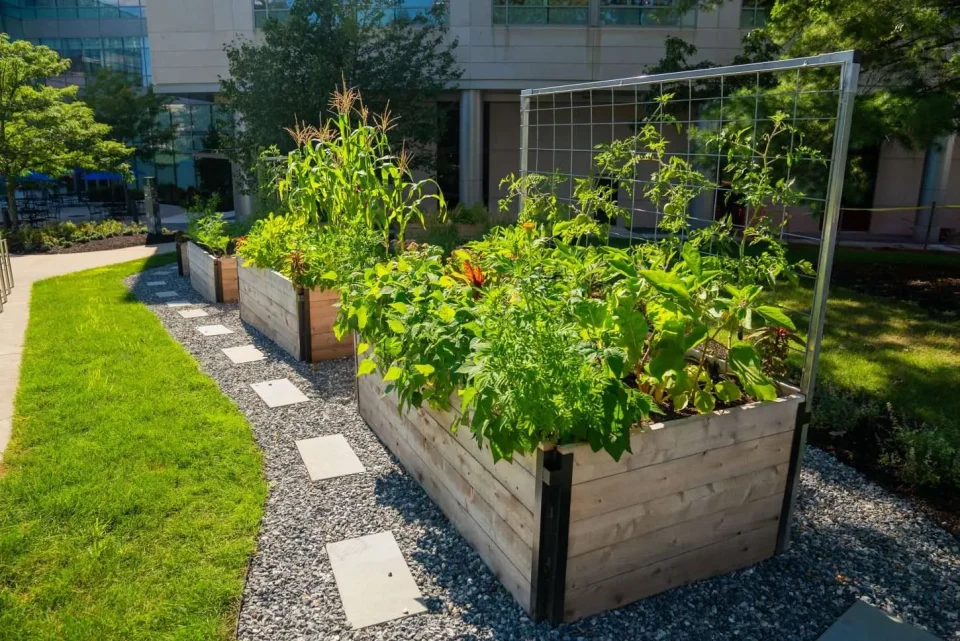In an age where space is becoming an increasingly valuable commodity, particularly in urban environments, the concept of gardening is undergoing a transformation. Whether you live in a compact city apartment with a small balcony or a larger suburban home, the rise of urban gardening has made it possible for anyone, regardless of space constraints, to enjoy the benefits of gardening. However, this brings up a fundamental question: Should urban gardens rely on the conventional planting of individual plants, or does the concept of an integrated, structured urban garden work better for maximizing space and utility? This article explores the differences between urban gardens and traditional plant-focused gardening, highlighting the advantages and challenges of each in the context of today’s urban lifestyle.
1. What is an Urban Garden?
An urban garden is a well-defined, intentional effort to cultivate plants in city environments. These gardens can range from small balcony or rooftop gardens to larger community garden plots, often involving techniques that maximize limited space. Urban gardening doesn’t always require the traditional in-ground planting of individual plants. Instead, it may involve raised beds, vertical gardening, container gardening, hydroponics, or even aquaponics. The goal is to bring nature into urban spaces, offering an oasis of green that’s not just about aesthetic appeal but also sustainability and functionality.
Urban gardens tend to be high on innovation. They involve creative use of materials and often focus on growing edible plants like vegetables, herbs, and fruits. This type of gardening can be especially appealing to individuals who want to have more control over their food supply or create a more eco-friendly lifestyle. These gardens also encourage self-sufficiency, reduce carbon footprints, and often foster a sense of community, particularly in shared spaces.
2. The Appeal of Traditional Plant-Based Gardening
Traditional plant-based gardening, on the other hand, is rooted in planting individual species in the ground or using conventional containers. This is the method many gardeners have been familiar with for centuries, characterized by flower beds, vegetable rows, or fruit orchards. The focus here is on the plants themselves—on nurturing species to grow as they naturally would in a specific climate, soil, and environment.
The appeal of traditional plant-based gardening lies in its simplicity and connection to nature. Gardeners can enjoy the therapeutic act of planting seeds, watching them grow, and tending to them as they flourish over time. This type of gardening is particularly appealing to people with larger spaces, such as suburban homes or rural properties, where land is abundant, and the freedom to plant diverse species can be fully realized. It also offers the chance to experiment with larger garden designs, creating diverse ecosystems that attract wildlife, enhance biodiversity, and beautify the surrounding area.
3. Space Considerations: Urban Gardening Wins the Day
Perhaps the most significant factor differentiating urban gardening from traditional plant-based gardening is the space available for cultivation. Cities are often characterized by limited outdoor space—balconies, rooftops, patios, or small yards are the common settings for an urban garden. Urban gardeners are challenged to find innovative ways to maximize space and grow plants, often resorting to vertical gardens, container gardening, or hydroponic setups that allow for growth in a confined area.
In contrast, traditional gardening benefits from more expansive outdoor spaces. Whether it’s a sprawling suburban backyard or a rural property, there is more room to grow. Large garden beds, orchards, or flower-filled lawns are easier to achieve in these environments. For those fortunate enough to have the land, the planting of individual plants allows for a more diverse garden that might include expansive vegetable plots, flower beds, and even trees.
The growing trend of urban gardening has proven that small spaces don’t limit creativity. Urban gardeners use vertical racks, window boxes, and hanging planters to expand their reach. For city dwellers with limited space, the opportunity to grow a small garden in a confined area can be incredibly rewarding. Additionally, the flexibility of urban gardens means that gardeners can adapt and experiment with new technologies, such as self-watering systems, greenhouse enclosures, and aeroponic systems, that make the most of every square inch.
4. Sustainability: A Strong Argument for Both Models
When it comes to sustainability, both urban gardening and traditional plant-based gardening offer compelling benefits. However, the nature of the benefits differs in each case.
Urban gardening is inherently more sustainable due to its focus on minimizing waste, reducing the urban heat island effect, and creating a more resilient local ecosystem. Growing food in urban areas decreases the need for long-distance transportation of produce, reduces packaging waste, and allows for better control over the use of pesticides and fertilizers. Moreover, urban gardens—particularly those that rely on container gardening or hydroponics—can often be watered more efficiently, reducing water waste in comparison to traditional methods. The integration of green spaces in cities can also help to absorb carbon dioxide, mitigate pollution, and provide a habitat for local wildlife, like birds and insects.
On the other hand, traditional gardening in suburban or rural areas contributes to sustainability by promoting the growth of local flora, maintaining natural habitats, and reducing the environmental costs associated with mass-produced plants. Larger gardens have the potential to create more biodiversity, supporting pollinators and native species. Furthermore, if done properly, traditional gardening allows for larger-scale cultivation of edible plants, encouraging the local production of food and minimizing reliance on industrial agriculture.
While urban gardening certainly has its advantages in terms of sustainability, both models—when executed with care—contribute to creating greener, more environmentally friendly spaces. It is less about one being better than the other and more about how each gardening model can fit into its respective environment, maximizing both ecological and social benefits.
5. Maintenance: A Question of Time and Effort
When it comes to maintenance, traditional plant-based gardening can often be more labor-intensive. This is particularly true for larger gardens that require more upkeep, such as lawn care, trimming, watering, and pest control. Additionally, traditional gardening may require more extensive tools, like tillers, shovels, or rakes, and may take up more of a gardener’s time. For individuals with limited free time or those who are not keen on working in the garden every day, this can become overwhelming.
In contrast, urban gardens—especially those utilizing vertical gardening or container gardening—are often easier to maintain. These gardens typically require less weeding, less soil turnover, and can often be set up to be more self-sustaining. Technologies like automated irrigation systems, raised beds, and self-watering containers make it easier to care for urban gardens with minimal effort. However, while less labor-intensive, urban gardens may require more planning in terms of design and the right combination of tools to optimize space.
6. Aesthetic Appeal: Urban Gardens vs. Traditional Plant Gardens
Both urban gardens and traditional plant-based gardens have their own aesthetic appeal, but the styles differ significantly.
Urban gardens tend to emphasize creative and minimalist designs that make use of space efficiently. They often incorporate modern elements like sleek planters, raised garden beds, and decorative features such as wind chimes, fairy lights, or small sculptures. The visual appeal comes from the clever integration of plants into the surroundings—whether it’s a lush green wall or a vibrant rooftop garden overlooking the city skyline.
Traditional plant-based gardens, on the other hand, offer more opportunities for diversity in plant choice, design, and layout. With more space to work with, gardeners can experiment with layered plantings, flower borders, herb gardens, fruit trees, and sprawling lawns. These gardens can be lush and expansive, offering a sense of harmony and serenity that comes from immersing oneself in nature. For many, there is something deeply fulfilling in tending to a large garden and watching it evolve season after season.
Conclusion: What Works Best?
Ultimately, deciding whether an urban garden or traditional plant-based garden works best depends on your space, time, and lifestyle. If you live in an urban environment with limited space but want to experience the joy of growing plants, an urban garden might be the best choice. Through creative techniques like container gardening, vertical planting, and hydroponics, urban gardens make the most out of small spaces and provide an eco-friendly, sustainable way to live. However, if you have more land available, traditional plant-based gardening offers a greater sense of freedom and the opportunity to experiment with a wider variety of plants, creating expansive outdoor spaces that bring tranquility, beauty, and functionality to your home.
Both gardening models offer tremendous benefits to individuals and the environment. Whether you opt for the efficiency and ingenuity of an urban garden or the timeless appeal of a traditional garden, the goal remains the same: cultivating a space that reflects your values, enhances your lifestyle, and brings you closer to nature.

